
Marston is a village and civil parish in the unitary authority of Cheshire West and Chester, in the northwest of England. The settlement is on the River Weaver, close to Anderton and the Anderton Boat Lift. The nearest major settlement to Marston is Manchester, which lies 15 miles (24 km) to the northeast. It is the site of the Lion Salt Works, now an industrial museum.

Northwich is a market and port town and civil parish in the unitary authority of Cheshire West and Chester in the ceremonial county of Cheshire, England. It lies in the heart of the Cheshire Plain, at the confluence of the rivers Weaver and Dane. The town is about 18 miles (29 km) east of Chester, 15 miles (24 km) south of Warrington, and 19 miles (31 km) south of Manchester.
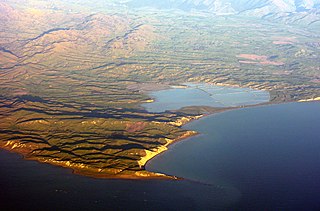
Lake Grassmere / Kapara Te Hau is a New Zealand waituna-type lagoon in the northeastern South Island, close to Cook Strait. The lake is used for the production of salt.

Salt, also referred to as table salt or by its chemical formula NaCl, is an ionic compound made of sodium and chloride ions. All life depends on its chemical properties to survive. It has been used by humans for thousands of years, from food preservation to seasoning. Salt's ability to preserve food was a founding contributor to the development of civilization. It helped eliminate dependence on seasonal availability of food, and made it possible to transport food over large distances. However, salt was often difficult to obtain, so it was a highly valued trade item, and was considered a form of currency by certain people. Many salt roads, such as the Via Salaria in Italy, had been established by the Bronze Age.
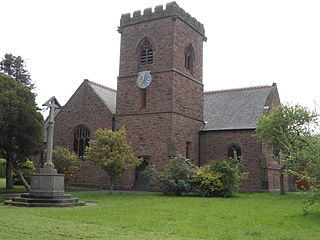
Winsford is a town and civil parish in the unitary authority of Cheshire West and Chester and the ceremonial county of Cheshire, England, on the River Weaver south of Northwich and west of Middlewich. It grew around the salt mining industry after the river was canalised in the 18th century, allowing freight to be conveyed northwards to the Port of Runcorn on the River Mersey. The town of Winsford has an estimated population of 35,000 in 2023.
Middlewich, a town in northwest England, lies on the confluence of three rivers – the Dane, the Croco and the Wheelock. Most importantly for the history of salt making, it also lies on the site of a prehistoric brine spring.

Moulton is a civil parish and village in Cheshire, England, 3 miles (4.8 km) south of Northwich and 3 miles (4.8 km) north of Winsford.
Middlewich is one of the Wich towns in Cheshire, England.
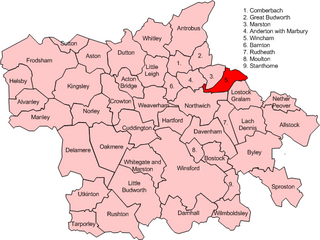
garden in the grounds is managed by Butterfly Conservation.

The Lion Salt Works is the last remaining open pan salt works in Marston, near Northwich, Cheshire, England. It closed as a work in 1986 and is now preserved as a museum.

Cheshire is a county in North West England. Rock salt was laid down in this region some 220 million years ago, during the Triassic period. Seawater moved inland from an open sea, creating a chain of shallow salt marshes across what is today the Cheshire Basin. As the marshes evaporated, deep deposits of rock salt were formed.

Open-pan salt making is a method of salt production wherein salt is extracted from brine using open pans.
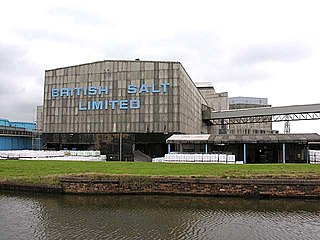
British Salt Limited is a United Kingdom-based chemical company that produces pure white salt. The company is owned by Tata Chemicals Europe after a buy out from private equity company LDC in April 2010. It is based in Middlewich, Cheshire, employs 125 people, and produces approximately 800,000 tonnes of pure white salt every year.
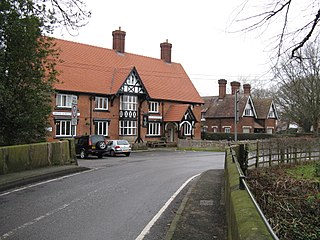
Warmingham is a village and civil parish in the unitary authority of Cheshire East and ceremonial county of Cheshire, England, on the River Wheelock, 3.25 miles (5.23 km) north of Crewe, 3.25 miles (5.23 km) south of Middlewich and 3.25 miles (5.23 km) miles west of Sandbach. The parish also includes the small settlement of Lane Ends, with a total population of just under 250. Nearby villages include Minshull Vernon, Moston and Wimboldsley.
The history of Northwich can be traced back to the Roman period. The area around Northwich has been exploited for its salt pans since this time. The town has been severely affected by salt mining with subsidence historically being a large issue. A programme of mine stabilisation has recently been undertaken.

Marston is a village and a civil parish in Cheshire West and Chester, England. It contains eight buildings that are recorded in the National Heritage List for England as designated listed buildings, all of which are at Grade II. This grade is the lowest of the three gradings given to listed buildings and is applied to "buildings of national importance and special interest". Running through the parish is the Trent and Mersey Canal. The listed buildings consist of a milepost on the canal, a farmhouse and farm building, a war memorial, and four structures associated with the Lion Salt Works. The latter is also a scheduled monument. It is "the only substantially intact example in the county of a works producing white crystal salt by the evaporation method", and houses "the only remaining natural brine pumping open pan salt works in Europe".

Sir Joseph Verdin, 1st Baronet, was a British salt industrialist, philanthropist and the Justice of the Peace, Deputy Lieutenant and County Alderman for the County of Cheshire. He was elevated to the Baronetage on 24 July 1896 and knighted in 1897. He later became Justice of the Peace for Herefordshire and High Sheriff in 1903.

A flash is a body of water that forms where the land below it has subsided. Whilst these are mostly found in areas where mining has taken place, some can occur naturally. Collectively they are known as Flashes
The Percival Lane power station in Runcorn was built and operated by the Mersey Power Company Limited. It comprised two stations A and B commissioned in 1921 and 1941. The station supplied electricity to commercial, industrial and domestic users over a wide area of 95 square miles around the River Mersey including Widnes, Ellesmere Port and Runcorn.

Winsford Mine is a halite mine in the town of Winsford, Cheshire, England. The mine produces an average of 1,500,000 tonnes of rock salt a year, which is used to grit public roads in the United Kingdom during the winter months. Two other mines also produce rock salt within the United Kingdom, but Winsford has the biggest output of all three and has the largest market share.















